Georgia WWSCAN biweekly update 9/29/2023
Welcome to the bi-weekly update for WWSCAN partners in Georgia! The samples provided up through 9/25/23 have been processed in the lab and data are on the site at data.wastewaterscan.org.

If you notice any bugs on the site or have any comments about it, please continue to send your feedback via email Amanda Bidwell at albidwel@stanford.edu. We thank you for your partnership!
Infectious Disease Target Review
Currently monitoring a suite of Respiratory, Gastrointestinal and Outbreak Pathogens of Concern
New pathogen results (for EVD68, Adenovirus group F, Rotavirus, Candida auris, and Hepatitis A) became available on the main data.wastewastescan.org site on Monday, Sept 25, 2023.

The methods for our assays are in the public domain. You can access them using these QR codes:

Wastewater Categories
Looking at trends, levels, and frequency of detection to categorize what we are seeing in wastewater
WastewaterSCAN uses a Wastewater Categorization system to communicate important insights from recent wastewater results. Research shows that the measurements we make in wastewater are related to disease in the community. The wastewater categorization helps us quickly understand if the recent measurements for a disease fall into a low, medium, or high category and are determined based on a combination of the following variables:
- Trends indicate whether wastewater concentrations of pathogens have been changing significantly (i.e., increasing or decreasing) for each location over the last 21 days
- Levels indicate whether wastewater concentrations are relatively lower or higher at each location compared to national concentrations of each pathogen (i.e., upper third, middle third, or lower third, as measured over the last year)
- Frequency of detection indicates how often a pathogen is detected in wastewater for each location over a recent time period (e.g., the last 10 days)
The new Wastewater Categorization system can now be accessed on the map view of the data.wastewaterscan.org site!
The Wastewater Categories are broken up into 3 archetypes for WWSCAN Pathogens:
- Pathogens that are commonly detected (regardless of season) - SARS-CoV-2, Norovirus, and ‘peak season’ Respiratory pathogens (IAV, RSV, HMPV)

- Seasonal pathogens (rarely detected outside of season/outbreaks) - IAV, RSV, HMPV
The methodology used to determine seasonal Onset vs Offset using raw target concentrations (not PMMoV Normalized) for individual sites is as follows:
- The onset dates of IAV, RSV, and HMPV wastewater events are identified as the first day for which all samples in a 14 day look back period had concentrations higher than or equal to 2,000 copies/g, which is approximately twice the lowest detectable concentration. Once IAV, RSV, or HMPV are onset, the method for 'commonly detected pathogens' (see above) is used to determine the wastewater categorization.
-The offset dates of IAV, RSV, and HMPV wastewater events were identified as the first day after an onset event for which only 50% of samples during a 14-d look back period have concentrations higher than or equal to 2,000 copies/g. When one of these signals is in offset, it is assigned a ‘LOW’ categorization
- Pathogens that are not commonly detected (regardless of season) - Mpox

Respiratory Pathogens
SARS-CoV-2, Influenza A & B, Respiratory Syncytial Virus, & Human metapneumovirus
SARS-CoV-2 RNA concentrations have been less than 630,000 copies per gram in the last two weeks. The chart below shows the raw data since December 2022 and the population-weighted aggregated trend line for all 8 Georgia sites when the data is normalized by PMMoV. The aggregated line and the National Levels benchmarks illustrate that SARS-CoV-2 N gene RNA concentrations among Georgia sites are still approaching the middle third level of all concentrations measured in the last year.
As of 9/29/23, Little River is in the HIGH (1 site) category, Big Creek, Johns Creek, Utoy Creek, and South River are in the MEDIUM (4 sites) category, and RM Clayton, College Park, and Columbus are in the LOW (3 sites) category.
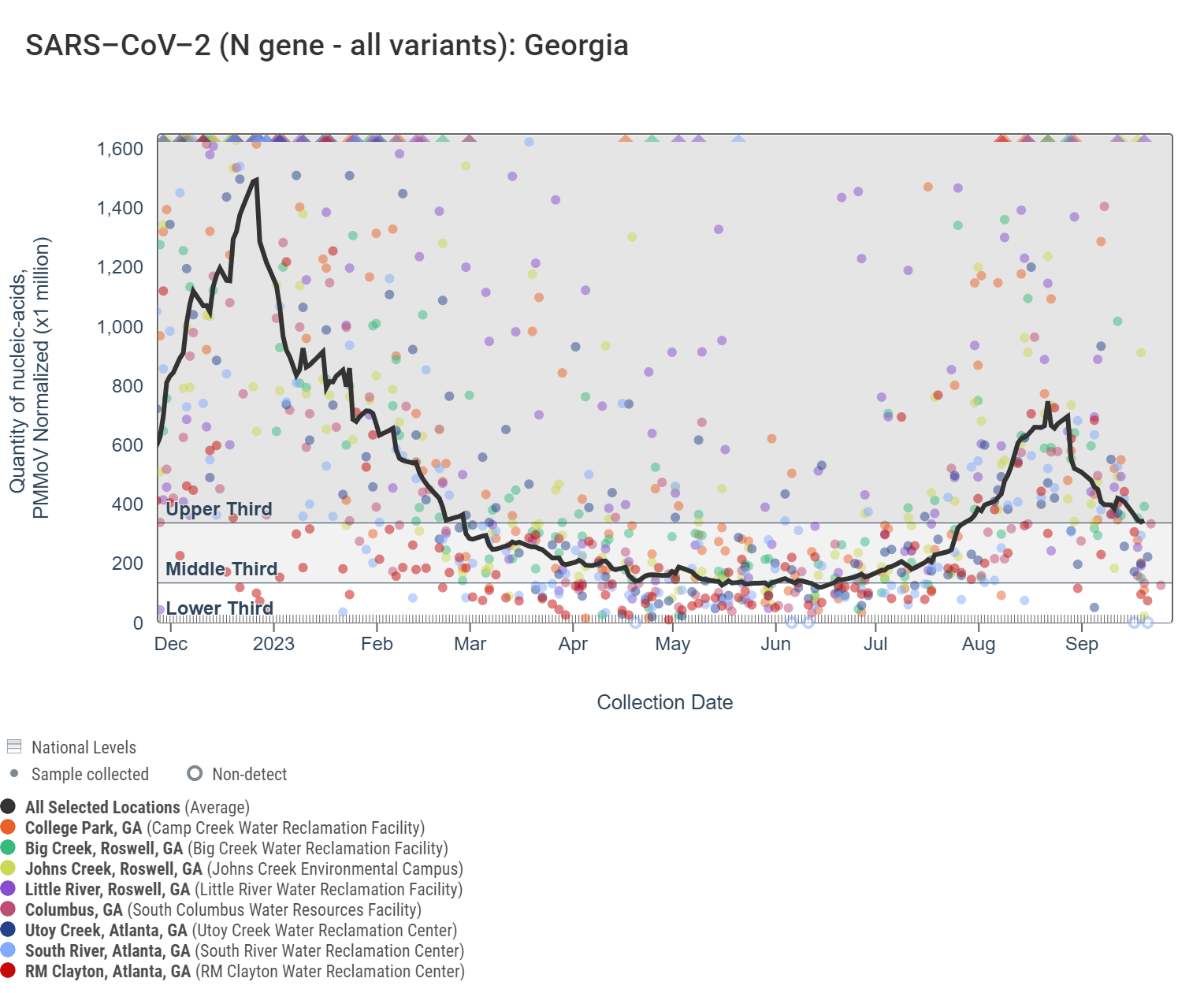
Influenza A (IAV) RNA has been detected at low concentrations at Big Creek, Columbus, and RM Clayton within the last two weeks as seen in the heat map below. All 8 Georgia sites are in the LOW Wastewater Category (not in onset) based as of 9/29/23.
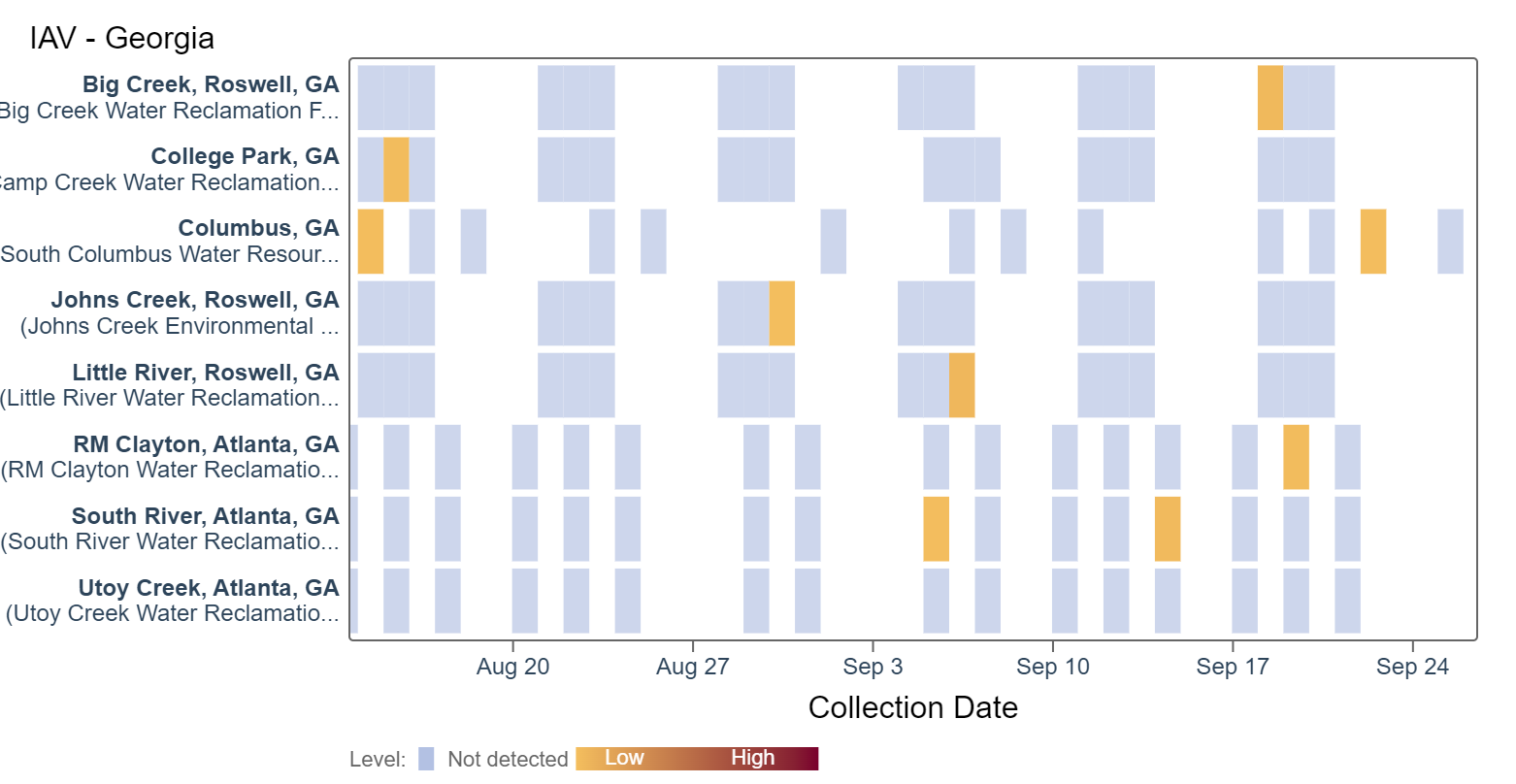
Influenza B (IBV) RNA continues to be rarely detected at most sites. It has been more frequently detected in samples collected from the Columbus site, where concentrations have slightly increased and are now below 5800 copies/g. All 8 Georgia sites are in the LOW Wastewater Category (not in onset) based as of 9/29/23.
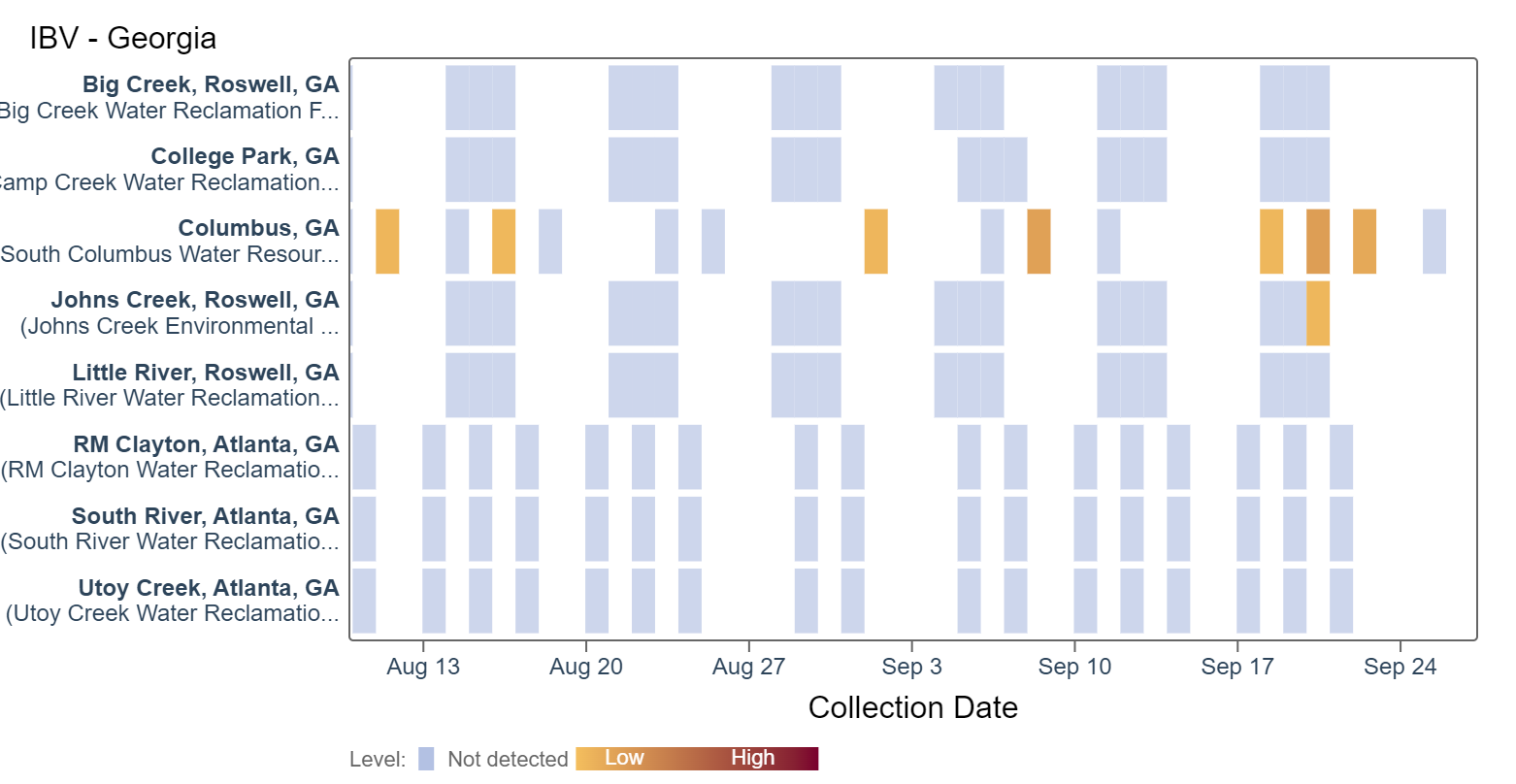
Respiratory syncytial virus (RSV) RNA concentrations have increased in the last two weeks and are less than 15,000 copies/g. The chart below includes the 5-day trimmed lines for each site plus the population-weighted average line showing that RSV RNA concentrations among the 8 Georgia sites are in the upper third level of all concentrations measured in the last year.
Most Georgia sites (7) are in the LOW Wastewater Category (not in onset) based as of 9/29/23; College Park is in the HIGH category.
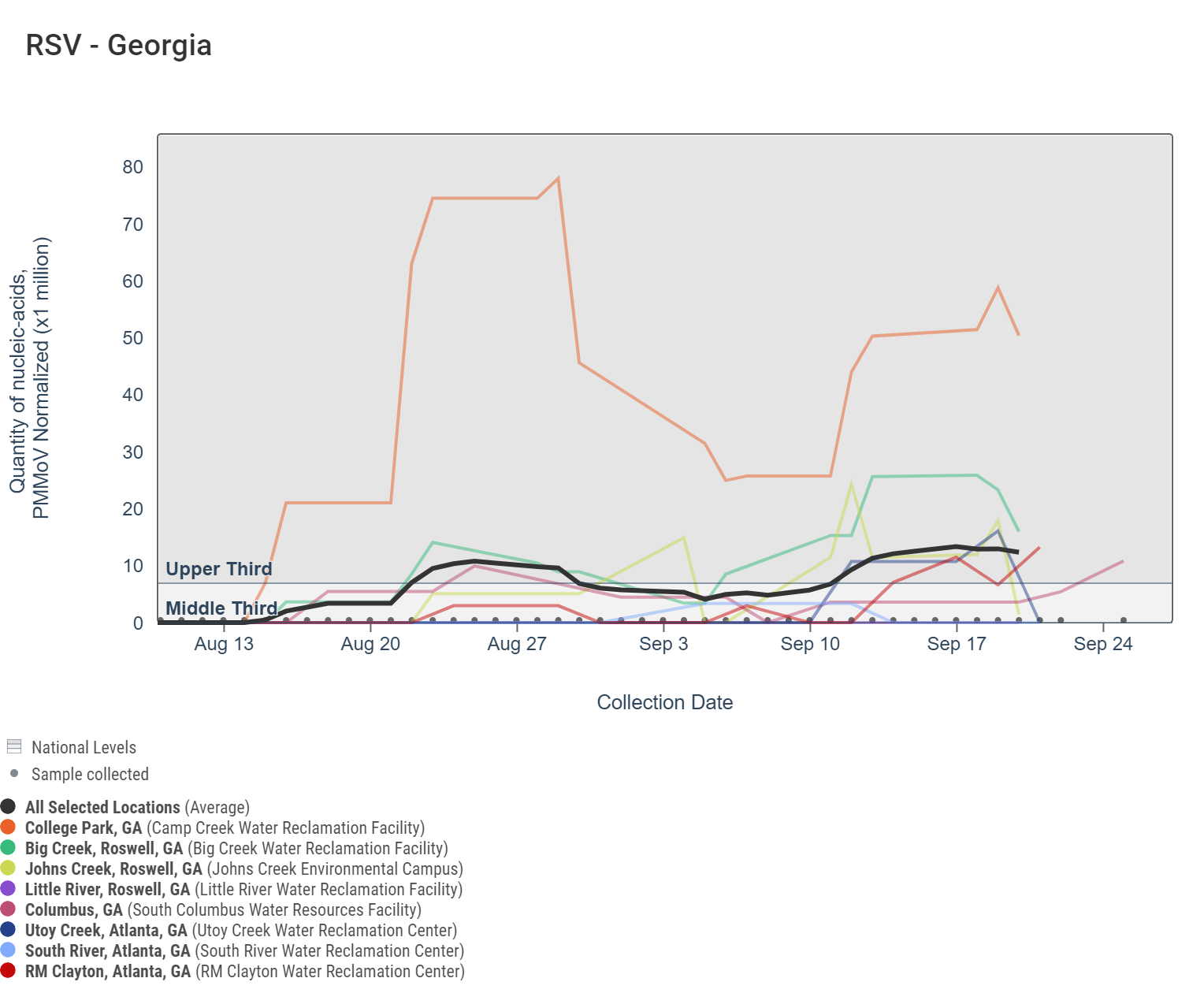
HMPV (human metapneumovirus) RNA concentrations are low and below 4800 copies/g. According to this heat map, RSV RNA has been more frequently detected in the last few weeks at most sites except College Park, Columbus, and Little River. All 8 Georgia sites are in the LOW Wastewater Category based on sample collection through 9/20/23.

Gastrointestinal Pathogens
Gastrointestinal pathogens cause diseases with symptoms including but not limited to vomiting and diarrhea
Norovirus GII (HuNoV GII) RNA concentrations have increased to range between 125,000 - 11,400,000 copies/g and the population-weighted average line for the 8 Georgia sites is now within the middle third level.

Below are the HuNoV GII wastewater categories for the 8 Georgia sites as of 9/29/23:
- College Park, Little River, Columbus, Utoy Creek, South River, and RM Clayton are in the LOW Wastewater Category
- Big Creek is in the MEDIUM Wastewater Category
- Johns Creek is in the HIGH Wastewater Category
Other Pathogens of Concern
Mpox
Mpox DNA results have been non-detect in the last 21 days at most Georgia plants except College Park, where a single detection occurred on 9/12/2023. This heat map shows data since July 2022. Sites are labeled in the rows and each date a sample was collected as a column. The color blue means the sample was non-detect for mpox DNA and the color maroon means Mpox DNA was detected.
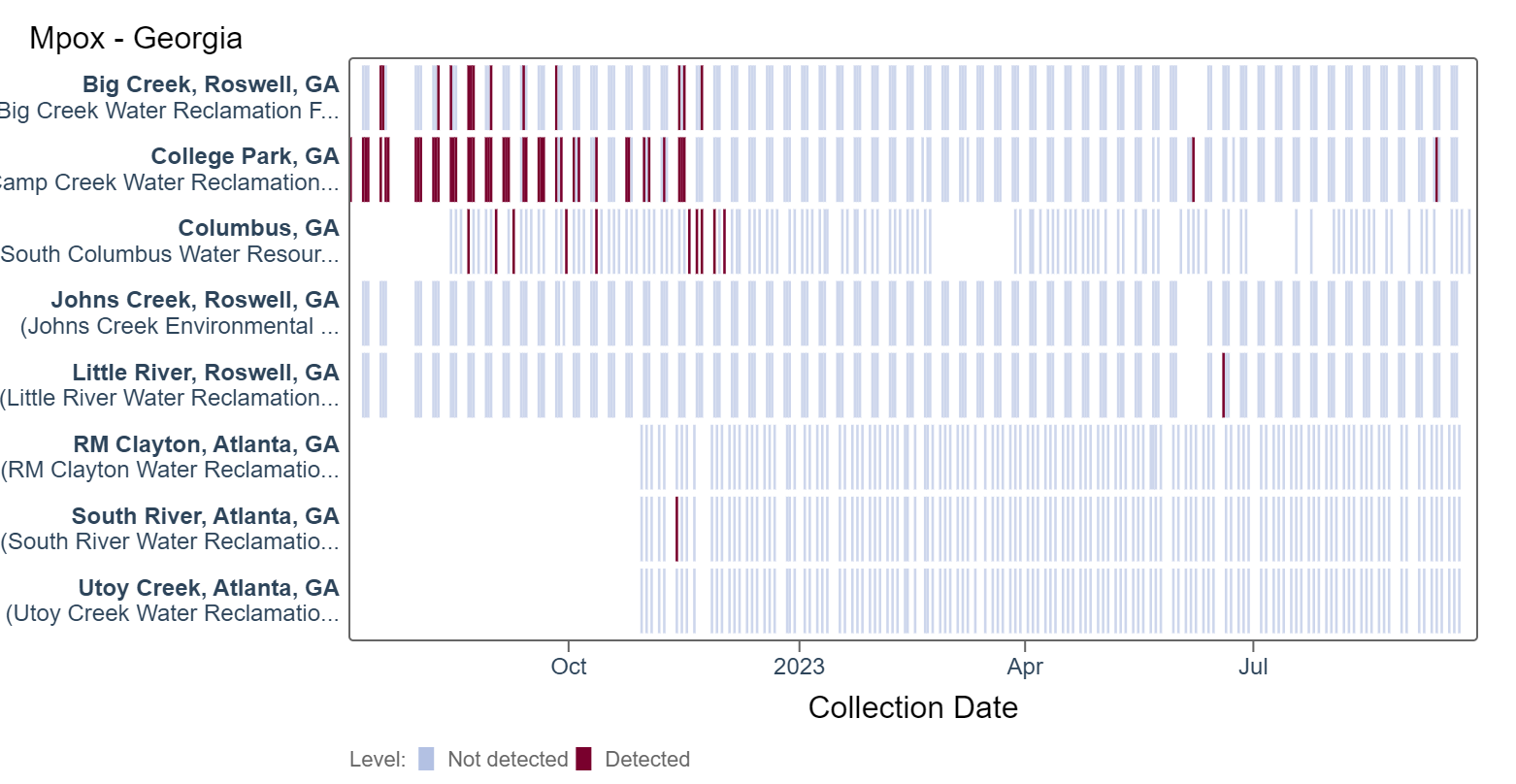
Related News
The next stakeholder meeting will take place Friday, October 13th @ 12 PM EST. At the October WWSCAN Stakeholder meeting, we will discuss results from the 1st month of new pathogen data collection (EV-D68, Rotavirus, Human Adenovirus Group F, Hepatitis A, and Candida auris) as well as new website features to help with interpreting wastewater trends and levels.
If you have questions about the website or anything else, submitting them in advance here will help us plan to address everything. We hope to see you there!
